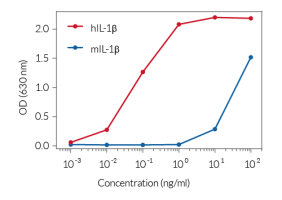THP1-Null Cells
-
Cat.code:
thp-null
- Documents
ABOUT
Positive control cell line for inflammasome studies
THP1-Null cells are derived from THP-1 human monocytic cells, which represent the most commonly used model cell line for the study of inflammasome activation as they express high levels of NLRP3, ASC, and pro-caspase-1.
![]() More details on THP1-Null cells
More details on THP1-Null cells
THP1-Null cells produce IL-1β upon stimulation with inflammasome inducers, such as MSU crystals and ATP.
As THP1-Null cells are fully efficient for NLRP3, Caspase 1 and ASC activities, they are the positive control cell line for THP1-defCASP1 Cells, which are deficient in Caspase 1.
Disclaimer: These cells are for internal research use only and are covered by a Limited Use License (See Terms and Conditions). Additional rights may be available.
SPECIFICATIONS
Specifications
Activated by inflammasome inducers (MSU crystals and ATP)
Complete RPMI 1640 (see TDS)
Verified using Plasmotest™
Each lot is functionally tested and validated.
CONTENTS
Contents
-
Product:THP1-Null Cells
-
Cat code:thp-null
-
Quantity:3-7 x 10^6 cells
- 1 ml of Hygromycin B Gold (100 mg/ml)
- 1 ml of Normocin™ (50 mg/ml)
Shipping & Storage
- Shipping method: Dry ice
- Liquid nitrogen vapor
- Upon receipt, store immediately in liquid nitrogen vapor. Do not store cell vials at -80°C.
Storage:
Caution:
Details
THP1-Null cells are designed to study the signals involved in inflammasome activation. To become susceptible to inflammasome inducers, these cells must be induced by stimuli commonly used for induction in model systems, such as lipopolysaccharide (LPS) and phorbol 12-myristate acetate (PMA). Stimulation by LPS or differentiation with PMA induces the production of pro-IL-1β, the immature form of IL-1β. Subsequent stimulation with inflammasome inducers, such as ATP and alum, leads to caspase-1 activation and IL-1β maturation and secretion. Mature IL-1β can be detected by Western blot, ELISA, or a cell-based assay.
InvivoGen has developed a new method to detect bioactive IL-1β, based on HEK293 cells specifically engineered to selectively respond to IL-1β, named HEK-Blue™ IL-1β. These cells feature the SEAP (secreted embryonic alkaline phosphotase) reporter gene under the control of an NF-kB-inducible promoter. They naturally express the IL-1β receptor (IL-1R), and all the proteins involved in the MyD88-dependent IL-1R signaling pathway that leads to NF-kB activation. Thus upon IL-1β binding to IL-1R, a signaling cascade is initiated triggering NF-kB activation and the subsequent production of SEAP. Detection of SEAP in the supernatant of HEK-Blue™ IL-1β cells can be readily assessed using QUANTI-Blue™ Solution, a SEAP detection medium. QUANTI-Blue™ Solution turns blue in the presence of SEAP which can be easily quantified using a spectrophotometer.
DOCUMENTS
Documents
Technical Data Sheet
Safety Data Sheet
Certificate of analysis
Need a CoA ?






